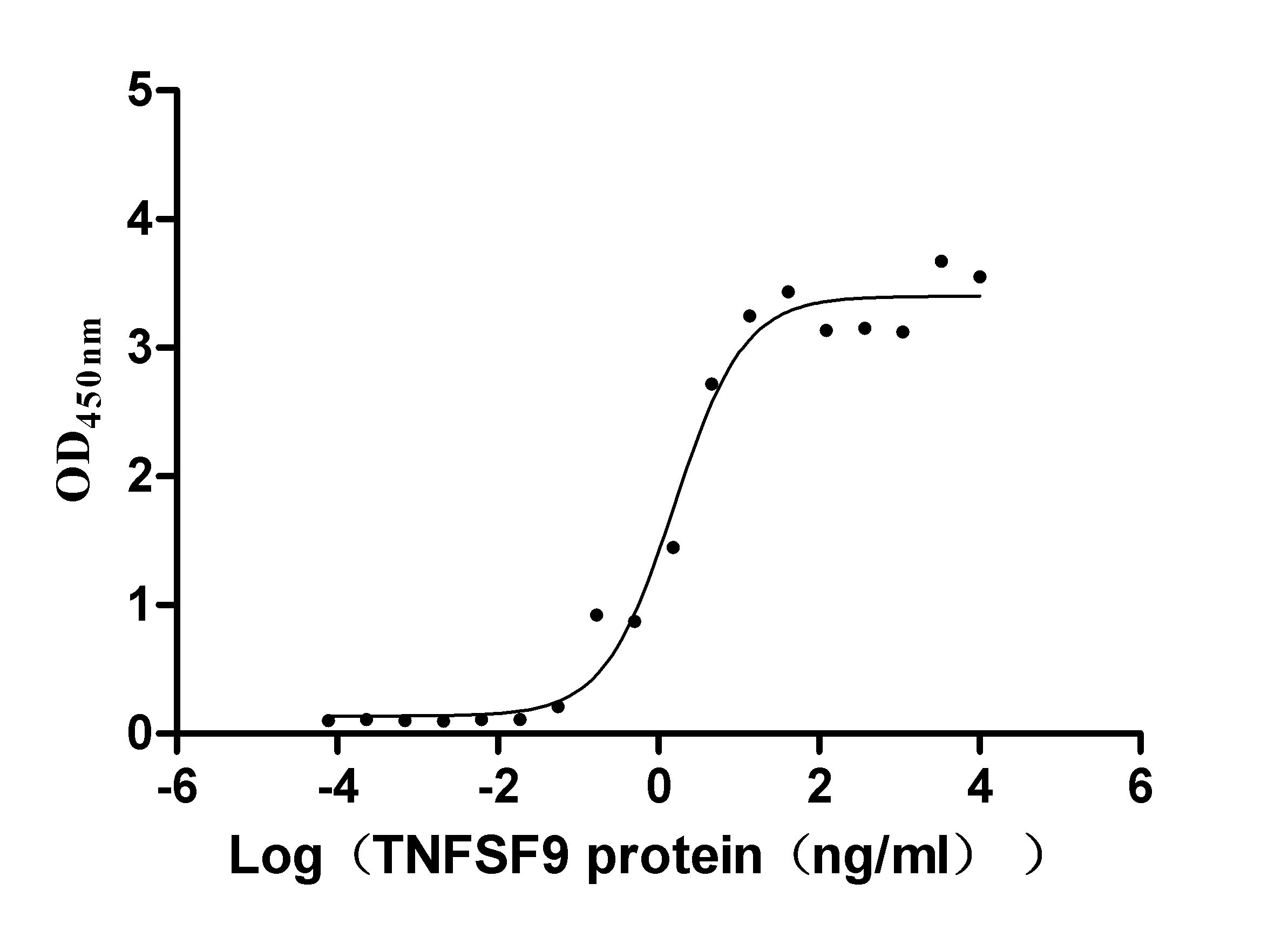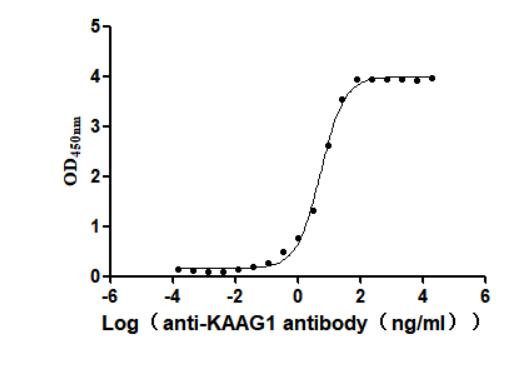Recombinant Hendra virus Fusion glycoprotein F0 (F), partial
-
中文名称:Recombinant Hendra virus Fusion glycoprotein F0(F),partial,Yeast
-
货号:CSB-YP526026HVN
-
规格:
-
来源:Yeast
-
其他:
-
中文名称:Recombinant Hendra virus Fusion glycoprotein F0(F),partial,Yeast
-
货号:CSB-EP526026HVN
-
规格:
-
来源:E.coli
-
其他:
-
中文名称:Recombinant Hendra virus Fusion glycoprotein F0(F),partial,Yeast
-
货号:CSB-EP526026HVN-B
-
规格:
-
来源:E.coli
-
共轭:Avi-tag Biotinylated
E. coli biotin ligase (BirA) is highly specific in covalently attaching biotin to the 15 amino acid AviTag peptide. This recombinant protein was biotinylated in vivo by AviTag-BirA technology, which method is BriA catalyzes amide linkage between the biotin and the specific lysine of the AviTag.
-
其他:
-
中文名称:Recombinant Hendra virus Fusion glycoprotein F0(F),partial,Yeast
-
货号:CSB-BP526026HVN
-
规格:
-
来源:Baculovirus
-
其他:
-
中文名称:Recombinant Hendra virus Fusion glycoprotein F0(F),partial,Yeast
-
货号:CSB-MP526026HVN
-
规格:
-
来源:Mammalian cell
-
其他:
产品详情
-
纯度:>85% (SDS-PAGE)
-
基因名:F
-
Uniprot No.:
-
别名:FFusion glycoprotein F0; Protein F) [Cleaved into: Fusion glycoprotein F2; Fusion glycoprotein F1]
-
种属:Hendra virus (isolate Horse/Autralia/Hendra/1994)
-
蛋白长度:Partial
-
蛋白标签:Tag type will be determined during the manufacturing process.
The tag type will be determined during production process. If you have specified tag type, please tell us and we will develop the specified tag preferentially. -
产品提供形式:Lyophilized powder
Note: We will preferentially ship the format that we have in stock, however, if you have any special requirement for the format, please remark your requirement when placing the order, we will prepare according to your demand. -
复溶:We recommend that this vial be briefly centrifuged prior to opening to bring the contents to the bottom. Please reconstitute protein in deionized sterile water to a concentration of 0.1-1.0 mg/mL.We recommend to add 5-50% of glycerol (final concentration) and aliquot for long-term storage at -20℃/-80℃. Our default final concentration of glycerol is 50%. Customers could use it as reference.
-
储存条件:Store at -20°C/-80°C upon receipt, aliquoting is necessary for mutiple use. Avoid repeated freeze-thaw cycles.
-
保质期:The shelf life is related to many factors, storage state, buffer ingredients, storage temperature and the stability of the protein itself.
Generally, the shelf life of liquid form is 6 months at -20°C/-80°C. The shelf life of lyophilized form is 12 months at -20°C/-80°C. -
货期:Delivery time may differ from different purchasing way or location, please kindly consult your local distributors for specific delivery time.Note: All of our proteins are default shipped with normal blue ice packs, if you request to ship with dry ice, please communicate with us in advance and extra fees will be charged.
-
注意事项:Repeated freezing and thawing is not recommended. Store working aliquots at 4°C for up to one week.
-
Datasheet :Please contact us to get it.
靶点详情
-
功能:Class I viral fusion protein. Under the current model, the protein has at least 3 conformational states: pre-fusion native state, pre-hairpin intermediate state, and post-fusion hairpin state. During viral and plasma cell membrane fusion, the heptad repeat (HR) regions assume a trimer-of-hairpins structure, positioning the fusion peptide in close proximity to the C-terminal region of the ectodomain. The formation of this structure appears to drive apposition and subsequent fusion of viral and plasma cell membranes. Directs fusion of viral and cellular membranes leading to delivery of the nucleocapsid into the cytoplasm. This fusion is pH independent and occurs directly at the outer cell membrane. The trimer of F1-F2 (F protein) probably interacts with G at the virion surface. Upon G binding to its cellular receptor, the hydrophobic fusion peptide is unmasked and interacts with the cellular membrane, inducing the fusion between cell and virion membranes. Later in infection, F proteins expressed at the plasma membrane of infected cells could mediate fusion with adjacent cells to form syncytia, a cytopathic effect that could lead to tissue necrosis.
-
基因功能参考文献:
- study found matrix (M) and F proteins each induced particle release when they were expressed alone but their coexpression led to coordinated assembly of virus-like particles (VLPs) that were morphologically and physically distinct from M-only or F-only VLPs; mutations to F protein transmembrane domain or cytoplasmic tail that disrupted endocytic trafficking led to failure of F to function with M for VLP assembly PMID: 28468881
- data suggest that the heptad repeat LIZ contributed to TM-TM association and is important for F protein function and pre-fusion stability. PMID: 28213515
- Residues S490 and Y498 of F protein transmembrane domain are critical for endocytic recycling. PMID: 22238299
- N-terminal end of the transmembrane domain of the F protein plays critical roles in fusion. PMID: 22238302
- Mutation of a histidine predicted to lie near the fusion peptide to alanine greatly reduced fusion despite wild-type cell surface expression levels, while asparagine substitution resulted in a moderate restoration in fusion levels. PMID: 20702638
- crystallographic analysis of the fusion core from Nipah virus and Hendra virus PMID: 15159588
- role in protein folding and transport as well as membrane fusion PMID: 15919949
- These results suggest that the critical F-G interactions occur only after the initial steps of synthesis and cellular transport. PMID: 19553334
显示更多
收起更多
-
亚细胞定位:Virion membrane; Single-pass type I membrane protein. Host cell membrane; Single-pass membrane protein.
-
蛋白家族:Paramyxoviruses fusion glycoprotein family
-
数据库链接:
KEGG: vg:1446467
Most popular with customers
-
Recombinant Human Semaphorin-4D (SEMA4D), partial (Active)
Express system: Mammalian cell
Species: Homo sapiens (Human)
-
Recombinant Human Tumor necrosis factor receptor superfamily member 9 (TNFRSF9), partial (Active)
Express system: Mammalian cell
Species: Homo sapiens (Human)
-
Recombinant Macaca fascicularis CD93 molecule (CD93), partial (Active)
Express system: Mammalian cell
Species: Macaca fascicularis (Crab-eating macaque) (Cynomolgus monkey)
-
Recombinant Human C-C chemokine receptor type 9 (CCR9)-VLPs (Active)
Express system: Mammalian cell
Species: Homo sapiens (Human)
-
Recombinant Human Kidney-associated antigen 1(KAAG1) (Active)
Express system: Baculovirus
Species: Homo sapiens (Human)

















